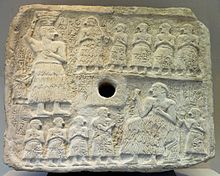Ur-Nanshe
[7] He is known to have originally built the Ibgal of Inanna, because of Eanatum's honorary inscriptions left after temple renovation.
An oval wall surrounds the main mud brick temple and it is located on the southwest edge of the city.
In the top register he is dressed in a kaunakes (tufted wool skirt), carrying a basket of bricks on his head while surrounded by other Lagash elite, his wife, and seven of his sons[12] (though it is possible female figure is instead the king's daughter[16]).
[7] A part of the inscriptions, in front of the seated king, reads: “Boats from the (distant) land of Dilmun carried the wood (for him)”.
The figures displayed are the king and his court standing rigid and wide eyed, paying homage to the god Nanshe.
𒌨𒀭𒀏 / 𒈗 / 𒉢𒁓𒆷 / 𒌉𒄖𒉌𒁺 / 𒂍𒀭𒊩𒌆𒄈𒋢 / 𒈬𒆕 Ur-Nanshe / lugal / Lagash / dumu Gunidu / E-Ningirsu / mudu
[8] Excerpt from Ruler of Lagash: “Ur-Nanše, the son of ......, who built the E-Sirara, her temple of happiness and Niĝin, her beloved city, acted for 1080 years.
She chose the šennu in her holy heart and seated Ur-Nanše, the beloved lord of Lagaš, on the throne.














